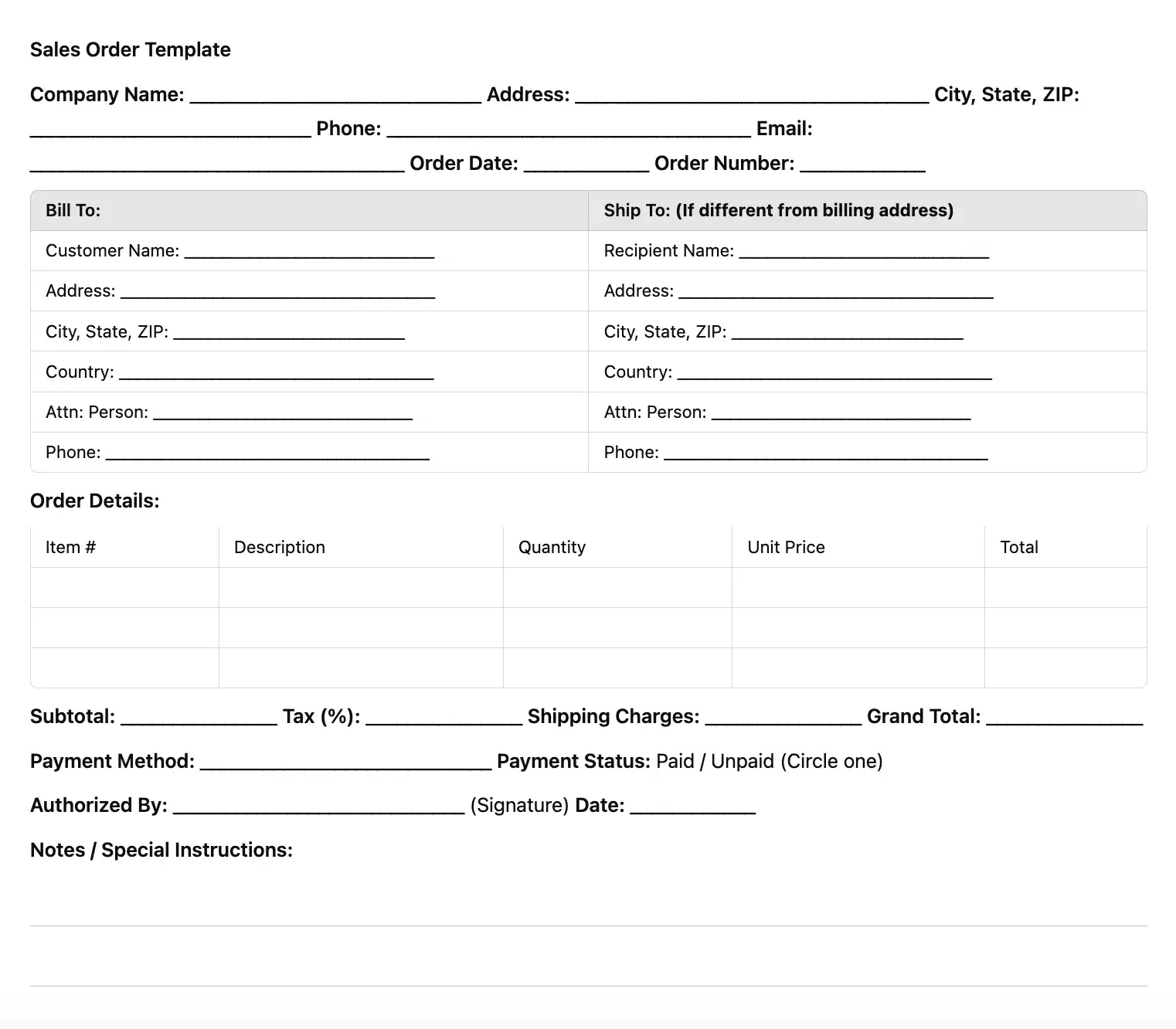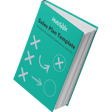I worked as an office assistant in the past. My job was to help the bookkeeper keep track of sales orders, invoices, and purchase orders. I learned rather quickly that there are major differences between the three documents (and they don’t all go within the same filing cabinet!).
I also learned that your role in the sales process determines which document you generate. For example, you’ll create the sales order if you're the seller.
Free Download: Sales Plan Template
So, what is a sales order, how is it different from other key sales documents, and how does it fit into your sales process? I’m glad you asked, and I’ll answer those questions and a few more below.
Table of Contents
- What Is a Sales Order?
- Why Are Sales Orders Important?
- How Are Sales Orders Different from Quotes?
- Why Are Invoices Important?
- Sales Order Example
- Sales Order Format
- Sales Order Process
What Is a Sales Order?
A sales order is a commercial document — prepared by a seller and issued to a customer — confirming the sale of goods or services involved in a given transaction.
Confusing this document with an invoice is common, but they are two documents with separate functions. As a business owner, I find it helpful to think of a sales order as a detailed summary of the goods or services I will provide to my customers.
A sales order contains details about the sale, including the quantity, quality, and price of any goods or services exchanged. It also covers things like delivery date, delivery address, payment method, and any other information relevant to the terms and logistics of the sale itself.
A sales order is an internal document — generated by the vendor and kept on record. This allows companies to keep track of the orders they fulfill.
Manufacturers, retailers, wholesalers, and supplies commonly use sales orders. However, you’ll find them used in nearly every industry and niche.
Types of Sales Orders
Like any other business document, there are variations to sales orders. The longer you’re in business, the more likely you will see four types of sales orders. Depending on the sale, one sales order type might work better than the others.
Cash Sales
In my opinion, cash sales are the simplest type of sales orders. You’ll use this sales order when a customer places an order and pays for it. Either they’ll pick up the order from your storefront, or you’ll issue a shipping date.
Cash sales are typically standard for B2C sales. In other words, the customer does not need to go through accounts receivable to purchase, and no purchase order is required. They simply give you their money, and you provide goods or services within an estimated time frame.
Rush Orders
Does your customer need their order as soon as possible? If so, I suggest using a rush order.
A rush order is used when a customer’s needs are met the same day the order is placed. This is usually well before the standard timeframe of delivery. Unlike cash sales, where the order is paid for before delivery, rush order payments are made after exchanging goods or services.
Scheduling Agreement
A scheduling agreement is an external document detailing delivery dates for goods and services, pricing, quantity, and payment terms.
Let’s pretend I am hosting three separate holiday parties. At each party, I want to serve charcuterie boards. When I place my order with the caterer, I tell them I do not want all three charcuterie boards delivered at the same time since my parties are on separate days.
Instead, I want one board delivered on the date of the first party, one on the date of the second party, and the final delivery on the date of the third party.
The scheduling agreement helps track delivery dates so that both the seller and the customer are on the same page.
Third-Party Order
If your business coordinates with another company for fulfillment and shipping, you’ll want to use third-party sales orders.
I like to think of third-party sales orders as “to-do lists” for the other company. While this type of sales order details delivery dates and payment information, it also doubles as a packing list. It helps the other company understand which products go into the box, where they should be shipped, and when.
Why Are Sales Orders Important?
If you’re a vendor, sales orders are crucial to keeping track of your inventory. They allow you and your business to stay on top of:
- What you have in stock.
- What you have on backorder.
- What you may need to purchase from your distributors.
Remember — agreeing to the terms of a purchase order usually makes a deal legally binding. If you have questions about a pending purchase order, seek legal counsel before signing. Trust me, maintaining detailed records of your sales orders will help ensure you can deliver on those agreements. And, when you can fulfill orders on time, you maintain your brand’s reputation.
Sales orders are also central to reducing the risk of material misstatement in your company’s financial reporting. Material misstatement is any kind of inaccuracy in a financial statement that may significantly impact the financial decisions of anyone relying on that statement’s information.
I’m not trying to stir panic, but material misstatements in reporting inventory balances can have some very real consequences.
For instance, misstating ending inventory can inflate or reduce your company's profits. As you can assume, neither of those outcomes looks good if you’re being audited.
Pro tip: It’s absolutely crucial to maintain accurate records of your sales orders. I suggest conducting quarterly internal audits to catch any potential material misstatements and ensure accuracy.

Free Sales Plan Template
Outline your company's sales strategy in one simple, coherent sales plan.
- Target Market
- Prospecting Strategy
- Budget
- Goals
Download Free
All fields are required.

How Are Sales Orders Different from Quotes?
I’m not a mind reader, but I bet the next question you might ask is, “Are sales orders different than quotes?”
The answer is yes. Sales orders are different from quotes.
Though vendor-generated sales orders and quotes discuss a potential sale, the two documents serve very different purposes. I like to think of a sales order as the byproduct of the sales process. It’s generated after a sales decision is made.
A quote is an estimation. It gives the buyer a general idea of how much they can expect to pay. The document contains an itemized list of products and services along with their respective prices and terms of sale.
A quote is non-binding. Once a buyer accepts a quote, they move to the next step in the process by sending a vendor something called a purchase order.
Sales Order vs. Purchase Order
When I worked as an office assistant, I became very familiar with purchase orders. A purchase order is an official confirmation of a buyer’s intent to purchase from a vendor. It’s a buyer-issued document that confirms certain aspects of a transaction, including details like prices and requested quantities.
For example, if I needed to purchase 23 notebooks at three dollars a piece, the purchase order would look like this:
- Quantity: 23 notebooks
- Unit price: $3.00
- Total price: $69.00
Once a vendor receives and accepts the terms of a purchase order, they create a sales order based on its details.
Sales orders and purchase orders are inherently interconnected. The key difference between them is who generates the document and who receives it.
A purchase order comes from a customer, is issued to a vendor, and lays out the terms of a potential sale. A sales order comes from a vendor, is issued to a customer, and confirms the vendor’s acceptance of the terms set in a given purchase order before delivery.
Once accepted by a vendor, a purchase order often constitutes a legally binding contract. If a vendor doesn’t deliver on the agreed terms of a purchase order, a buyer may take legal action against the seller in certain circumstances, and vice versa.
Sales Order vs. Invoice
Now that I’ve covered sales and purchase orders, the invoice is the next document in the sales process. If you’re wondering, “Is a sales order the same as an invoice?” The answer is no, and here’s why.
An invoice is sent from the seller to the buyer and specifies the amount of money the buyer owes a vendor for exchanging goods and services agreed upon in the sales and purchase orders. It can be easy to confuse sales orders with invoices. Both are vendor-generated and list the details of a specific sale.
However, the main distinctions between the two are highlighted in each document’s purpose and timing. A sales order confirms a sale and prompts a vendor to start assembling, packaging, or preparing the goods and services requested in a purchase order.
After this step, invoices are generated. Using the details specified in a sales order, invoices tell buyers how, when, and how much to pay for the goods and services they’ve purchased.
Pro tip: Check out these free invoices for an easy way to track your revenue and payments.
Why Are Invoices Important?
Invoices are essential because they definitively settle deals for vendors and set official payment timelines. Typically, 30 days is a standard payment timeframe. However, the timeline can vary from business to business. For example, in my business, some clients pay my invoices within 30 days and others within 60 days.
Invoices are essential for record-keeping purposes. An invoice is the most concrete evidence buyers and vendors have for a sale. Keeping track of invoices allows a company to stay on top of how much it’s spending or earning, which employees are responsible for any sales or purchases, and any outstanding debt the company may have.
As a business owner, I’ve found it’s proper practice for businesses to track invoices for tax purposes. The IRS suggests that businesses maintain a running summary of all business transactions. Keeping detailed records of invoices can be a critical part of that process.
Invoices also help businesses from a legal perspective. They provide documentation of how and when a customer bought goods or services from a vendor. A signed invoice shows a mutual understanding between a buyer and a vendor regarding a specific purchase, reducing the risk of legal action over pricing.
In other words, invoices are critical for tracking revenue and preventing potential legal or customer issues.
Pro tip: I highly recommend standardized invoice templates. I’ve found they speed up the drafting process and eliminate the risk of accidentally omitting essential items. You can use dedicated tools like HubSpot’s Invoice Generator to make this process quicker.
Sales Order Example

Sales Order Format
Now that I’ve explained a sales order, it's helpful to discuss the information your sales order should contain. As seen in the example above, typically a sales order includes the following:
- Company name and contact information.
- Customer name and contact information.
- Customer billing information.
- Customer shipping information.
- Product or service information.
- Price before taxes.
- Tax, delivery, and shipping charges.
- Total price after taxes.
- Any previous deposit.
- Current balance.
- Terms and conditions as defined by your company.
- Signatures.
- Any other relevant information as needed.
Pro tip: I’ve found keeping track of this information in a CRM helpful. For example, you can streamline the sales order process by pulling relevant customer details from your CRM and populating them into your sales order.
Sales Order Process
When I worked as a teacher, I found quick overviews helpful. Here’s a quick look at the sales process to see how the sales order, purchase order, and invoice fit together. Typically, the sales order process looks something like this:
- A customer sends a request for quote (RFQ) from a vendor.
- After receiving the RFQ, the vendor sends back a quote.
- The customer considers the quote reasonable and sends back a purchase order.
- The vendor receives the purchase order and uses its details to generate a sales order.
- The vendor sends the sales order to the customer to confirm the terms of the sale.
- The vendor assembles, packages, or prepares the goods and services requested.
- The vendor delivers those goods or services.
- Using the details of the sales order, the vendor generates an invoice and sends it to the customer.
- Ideally, the customer pays the amount specified on the invoice within the allotted time frame.
To recap, sales orders play a central role in ensuring that a sale is well-documented, properly conducted, and reflective of both sides' expectations.
It’s important that anyone consistently involved in sales — such as a vendor or a customer — has an understanding of these kinds of documents and the implications they may have on a company’s inventory, finances, and legal standing.
Editor's note: This post was originally published in November 2019 and has been updated for comprehensiveness.

Free Sales Plan Template
Outline your company's sales strategy in one simple, coherent sales plan.
- Target Market
- Prospecting Strategy
- Budget
- Goals
Download Free
All fields are required.



![Purchase Order: What It Is & How to Create One [+ Template]](https://knowledge.hubspot.com/hubfs/ft-po-in-business.webp)

![5 Reasons Why Sales Teams Miss Revenue Targets [+ How to Meet Them]](https://knowledge.hubspot.com/hubfs/revenue-targets-1-20250224-8507178.webp)






